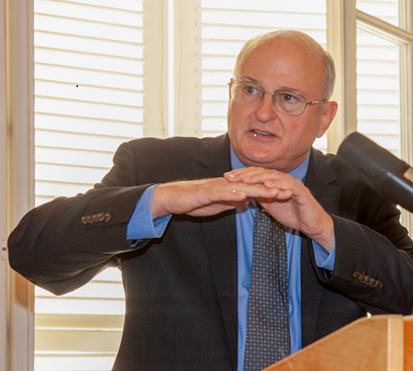Unlocking the power of the Hidden Middle: A key to global food security
By Thomas Reardon, University Distinguished Professor at Michigan State University and Non-Resident Senior Research Fellow at International Food Policy Research Institute
When we talk about food security, the conversation often focuses on farmers and consumers. But there’s a vital part of the food system that’s frequently overlooked - the “Hidden Middle.” This midstream segment of the food supply chain includes food processing, packaging, wholesaling, brokering, and logistics. It’s where raw agricultural products are transformed, moved, and made accessible to people everywhere. And it’s time we gave it the attention it deserves.
What is the Hidden Middle, and why does it matter?
The Hidden Middle is made up of both large enterprises and countless micro, small, and medium-sized businesses (MSMEs). These firms are the backbone of food systems in both high-income countries (the Global North) and lower- and middle-income countries (the Global South).
In 2015, I coined the term “Hidden Middle” to challenge the outdated idea of a “missing middle” - a notion that midstream services were either absent or inefficient, especially in the Global South1. In reality, the Hidden Middle is not missing at all. It’s thriving, evolving, and absolutely central to how food gets from farms to tables.
The Hidden Middle’s role in food security
Let’s break down how the Hidden Middle supports food security across three key dimensions:
1. Connecting consumers to nutritious, affordable food
In many countries, especially in the Global South, food security debates often overlook the role of food supply chains and, by extension, the Hidden Middle. There’s a common misconception that rural households mostly consume what they grow. But research shows that in Africa, around 60% of food is purchased, not self-produced. In Asia and Latin America, that figure rises to 80%.
This means that the vast majority of food consumed - both in cities and rural areas - flows through supply chains, and therefore through the Hidden Middle. In fact, 40-60% of the total costs and value added in food supply chains are generated in the Hidden Middle. That’s a huge share of national food security that’s often invisible in policy discussions.
2. Transforming food to meet consumer needs
Beyond moving food, the Hidden Middle adds value through processing and packaging. Think of dairy products, juices, and ready-to-eat meals, which are all made possible by midstream services. In the Global South, the shift from home-processed to packaged foods has accelerated over the past two decades.
Take Brazil’s dairy sector as an example. In the 1990s and 2000s, milk production soared, prices dropped, and consumption spread nationwide. The market shifted from the informal to the formal, and from fresh to packaged UHT milk. This transformation was driven by innovations in packaging, investment from companies like Tetra Pak, and collaboration between processors, retailers, and packagers. The result? Better access to nutritious dairy products for millions, including low-income households.
3. Empowering farmers to invest and grow
Farmers rarely sell directly to consumers or retailers. Their closest link is often with firms in the Hidden Middle - processors, packers, and wholesalers. These firms provide not just markets, but also incentives, standards, and support services like transport, credit, and information.
In Brazil, rising quality standards in the dairy sector pushed farms to upgrade technology and expand operations. In Poland, dairy companies helped small farms meet new requirements. These examples show how the Hidden Middle can drive both farm-level innovation and investment - often more effectively than government policies or training programs.
4. Building resilience and sustainability
The Hidden Middle also plays a critical role in making food systems more resilient and sustainable. By investing in technologies that reduce spoilage, improve energy efficiency, and minimize environmental impact, Hidden Middle firms help stabilize supply chains and reduce waste.
Their choices, from packaging materials to energy sources, shape the carbon footprint of the entire food system. And through contracts and partnerships, they can support farmers and suppliers in adopting sustainable practices.
Challenges and opportunities ahead
Despite its importance, the Hidden Middle faces significant challenges:
Exposure to global shocks: Midstream companies that operate across borders are vulnerable to trade disruptions, climate events, and policy changes. Coping with these shocks requires costly investments in infrastructure and diversification, which can lead to market concentration.
Navigating regulations and sustainability goals: Firms must balance efficiency, safety, and environmental impact. For example, packaging must protect perishable goods while meeting environmental regulations. This requires constant adaptation and innovation.
Infrastructure and business environment: In many parts of the Global South, MSMEs in the Hidden Middle struggle with poor roads, unreliable electricity, limited access to credit, and security concerns. These barriers raise costs and risks, stifling growth and innovation.
A call-to-action for policymakers and partners
The Hidden Middle is not just a link in the chain. It’s a powerful engine of transformation. Yet it remains under-leveraged in food security strategies. To unlock its full potential, we need:
Investment in infrastructure - both hard (markets, roads, energy) and soft (security, finance, training). Stable, supportive policies that reduce uncertainty and encourage innovation. Recognition of the Hidden Middle’s role in shaping outcomes for farmers, consumers, and the environment. Where these conditions are met, Hidden Middle firms thrive - and so do the food systems they support.
|
Dr. Thomas Reardon is a University Distinguished Professor at Michigan State University (MSU). |
Footnotes
1 Reardon, Thomas. (2015). The hidden middle: The quiet revolution in the midstream of agrifood value chains in developing countries. Oxford Review of Economic Policy. 31. 10.1093/oxrep/grv011.



